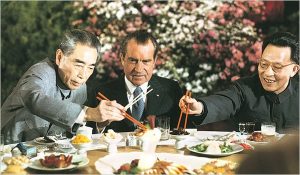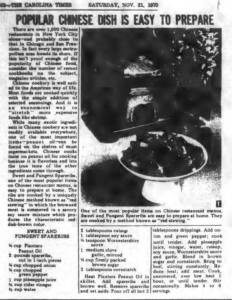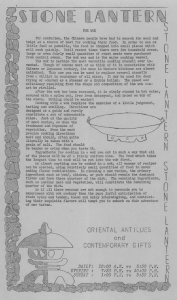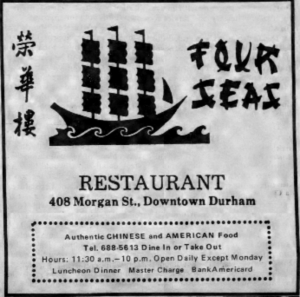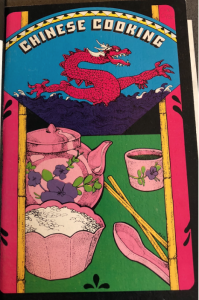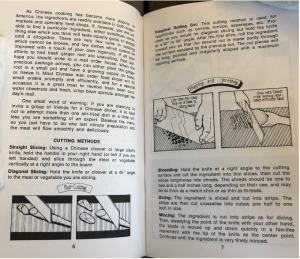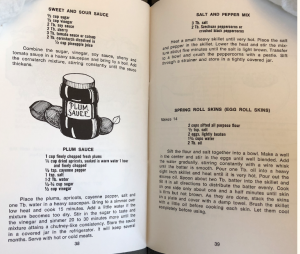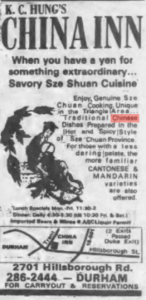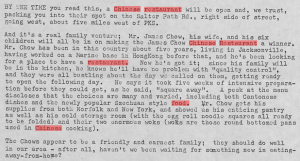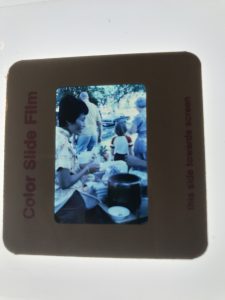1970s
What Happened? A Brief Look into the 70s: An Era of “Rapprochement”
(Source: ‘Nixon and Mao,’ New York Times, 2007)
~ President Richard Nixon and Chinese Premier Zhou Enlai can be pictured here sharing a meal of Chinese cuisine in Shanghai during Nixon’s visit in 1972.
Nixon’s Era:
1971: American and Chinese ping-pong athletes Glenn Cowan and Zhuang Zedong meet by chance in Japan. This friendly encounter allows American ping-pong athletes to visit China, creating a precedent for “Ping-Pong Diplomacy,” where China and America are growing in confidence with mutual trust.
February, 1972: Nixon conducts his journey to China, visiting Beijing, Hangzhou, and Shanghai (all the while eating each region’s cuisine). By the trip’s end, the U.S and China create the Shanghai Communique, which allows for the creation of liason offices in both Beijing and D.C. China’s cooperation with attempting to understand American political views led to a severe deteriorate in China’s relationship with the Soviet Russia.
1979: President Jimmy Carter and Vice Premier Deng Xiaoping attend the Joint Communique on the Establishment of Diplomatic Relations in D.C, solidifying discussion based on ideals that Taiwan is a part of China, establishment of embassies in each respective nation, economic, cultural, and commuter ties with one another.
1979-1980s (Present Day): In April 1979, the U.S. signs the Taiwan Relations Act, which establishes unofficial relationships in the forms of armament of Taiwan and unofficial political ties to take place. This legislative decision is pushed further by Taiwanese protests both in Taiwan and the U.S. Relationships with China become questioned and shaken due to negotiations with Taiwan. Even today, the so called “One China Policy” has become an international topic of debate, questioning the legitimacy of Taiwan and her relationship with the U.S.
What We Found:
1970:
This Durham newspaper, the Carolina Times, published two Chinese articles to emphasize the importance and significance of Chinese food and culture in America. Both articles share the recipes behind two Chinese dishes: Beef with Pepper and Tomatoes and Sweet and Pungent Spareribs. (Sourced from Digital NC Online Newspaper Archive Collections).
Source: Digital NC Newspapers
1971:
This Chinese Antique Store Flyer from Highlands, NC discusses the specialty items that are used by the Chinese, including cookware. This flyer features the wok, a versatile cooking utensil used by the Chinese in place of a skillet or saucepan and serves in many different styles of cooking from double boiling to steaming to deep frying. (Sourced from Digital NC Online Newspaper Archive Collections).
1972:
This ad from the Daily Tar Heel Newspaper in Chapel Hill displays a Chinese restaurant called Four Seas in downtown Durham. It emphasizes that both Authentic Chinese as well as American food is served there. As seen in many other Chinese restaurants, the ad states that it is open every single day except for Monday. (Sourced from Digital NC Online Newspaper Archive Collections).
Source: Digital NC Newspapers
1973:
This Chinese Cooking Cookbook published in Greensboro, NC shows a variety of different methods of slicing meats and vegetables in Chinese culture as well as recipes for both food and sauces of the Chinese cuisine. This cookbook can be found in the NC Special Collections in Wilson Library at UNC Chapel Hill.
1975
These two newspaper advertisements depict the sale of Chinese products, specifically in the wares of antiques and food products. By marketing the items as exotic, beautiful, and oriental, it is clearly designed to cater to the majority Caucasian-American public. The presence of these two sources supports the notion that Chinese-American relations are further renewed via economic trade.
Source: NC Digital Newspapers
1976
This radio transcript posted onto a local newspaper from Pine Knoll Shores NC highlights an interesting and exciting piece of news: the opening of a brand new Chinese restaurant in the locale. The source names a Mr. James Chow and his family as the owners of this new establishment and emphasizes the fact that the restaurant will cook and promote Cantonese and Szechuan Chinese foods. The source is indicative of a growing American interest and investment in Chinese culture, specifically with Chinese cuisine.
Source: Digital NC Newspapers
1980
This image was found in the Wilson Library under the category of Lawrence D. Kessler Collection. This was filed under the North Carolina Relations- China. This image was captioned as a Chinese lady cooking hot pot. This image shows the growing relationship North Carolina had with Chinese culture.
Research Method:
First, we searched through Digital NC through Wilson Library for terms like “Chinese restaurant,” “Chinese dish,” and Chinese food,” and limited it to the years 1970-1980. This gave us multiple newspapers for ads and recipes, as shown above. We then went to Wilson Library and searched for more documents, cookbooks, and photographs that contained the words, “Chinese food,” within it. We were able to find two documents that were relevant to the project: the cookbook and photograph above. We went back to Wilson Library a few times with different search terms such as “China in the 1970s”, “China”, and terms that were commonly used in a restaurant name. We found several directories that had these terms in the year we were assigned. These directories gave a clue of what type of restaurant names we should try to find.
